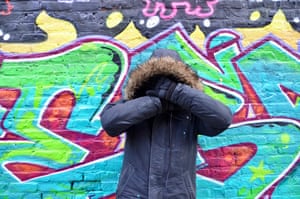It’s a blistery March afternoon and I am standing in a huddle of around 40 St John’s University freshmen outside of a high end coffee shop on the Lower East Side. We are all waiting for Leaf, our graffiti guide for the day from Graff Tours, a company that specializes in graffiti how-to workshops and tours of notable graffiti art.
Leaf is one of several instructors at the company: he’s a tall, thin young man with dark black plastic-frame glasses, a silver grill over his top teeth and tattooed letters spelling out “Brooklyn” over the knuckles of his hands. Today, he’s wearing a spray paint-splattered parka against the cold. He greets the students’ professor warmly – this field trip is part of the school’s Introduction to New York City class – and starts leading the group down streets with city sanctioned graffiti art installations and especially tagged-up buildings.

A graffiti class held by an instructor called Leaf in Manhattan in March. Photograph: Simon Leigh for the Guardian
Our tour group winds its way through the Lower East Side, stopping at notable murals and tags, each of which Leaf patiently explains in detail. The tags over there are called a “throwie” because you can just throw them up. The weird looking bubble-letters that flow like a Dali painting, those are called “wild style” – but that term isn’t cool, Leaf tells the class, because it’s not the 1980s anymore.
Next we admire a beautifully executed six-storey mural of a yellow creature on the side of a building, by artists from Brazil. The legally sanctioned mural will be obscured in a few months, Leaf explains, as the luxury rental building that will replace the gas station next to it rises up. Don’t feel too bad for the talented Brazilians, though; this mural may soon be lost to glass and steel, but they recently had a show in Chelsea.
Standing in front of a fading Invader mosaic, Leaf explains some of the practicalities of life as a modern day graffiti artist. Everyone uses e-commerce platform Big Cartel, which he describes as “Shopify [a more mainstream competitor] for criminals,” to sell their work. The really big artists like Katsu, who once tagged the perimeter of the White House (in a digitally enhanced prank video), have their own apps for sale through iTunes. Groups of graffiti artists who work together may be called crews or gangs, but they are not actual gang members, Leaf explains, in case there is any doubt.
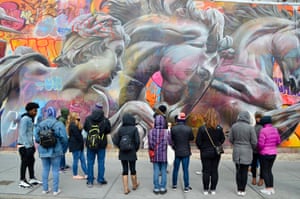
Leaf’s graffiti class in Manhattan, where he explained life as a modern artist. Photograph: Simon Leigh for the Guardian
Make sure to bring your permission slip
Many still think of graffiti as illicit, but these days, with so much work commissioned to decorate gates of bodegas and stores, it’s easy to get away with, Leaf says. If you’re spraying a bodega gate and the police approach you, you simply have to show them a “permission slip” that the bodega owner wrote for you, he explains, and most times the police won’t even bother reading it.
There are other ways to avoid detection: see those letters? Leaf asks the group, pointing to huge fuzzy writing several storeys up the side of a brick building. That’s done by filling a fire extinguisher with water and paint, and then getting it re-pressurized at a gas station, he explains to the students with a grin.
Recently used spray paint cans look suspicious to the police, he says, but having a used fire extinguisher on you is not a crime.
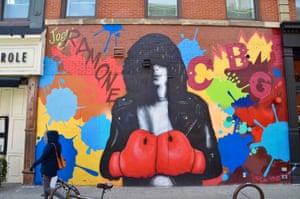
Street art in New York City on Leaf’s walking tour. Photograph: Simon Leigh for the Guardian
Hearing the words “permission slip” and graffiti in the same sentence is a jarring reminder of how different the city has become since the days when graffiti seemed to cover every surface in the 1970s. “I’ve only been arrested once in my life,” Leaf tells me sheepishly, glancing down at the ground.
Leaf grew up in a small town an hour outside Buffalo, New York, where he was inspired to explore graffiti by his father, himself an artist. Leaf remembers the exact moment when his father pulled over during a road trip to show him an old train car covered in graffiti when Leaf was 16 years old. Leaf decided he wanted to pursue the art form then and there, but he waited until he got to Brooklyn, four years later.
In his small home town, it would have been very easy to figure out among the town’s few teenagers was throwing up tags. His nom de paint can, Leaf, was also inspired by his move to the city. “Leaf, because New York City is a concrete jungle and I am putting leaves all over it,” he explains with another shy smile.
By now, we have made our way back to the canvas hung up over a fence in First Green Cultural Park, where the students will get to draw their first tags. Blue latex gloves are given out to protect fingers from the paint and Leaf, who keeps his already paint covered winter gloves on, demonstrates how to change the flow of the paint, fill in and shade letters and use color to full effect. Soon the air is filled with the noxious fumes from the paint and the laughter of college freshmen.
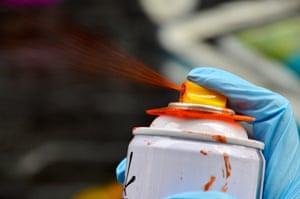
Students wear gloves to protect their fingers from the spray paint. Photograph: Simon Leigh for the Guardian
The abandoned factory and the painted rooftop
Gabe Schoenberg, the founder of Graff Tours, had worked as a tour guide on double-decker buses in New York City while in college, and helped an uncle who ran a Queens-based tour company, so starting a tour company of his own seemed like a logical next step. The company merely toured notable graffiti at first, but the business took off when Schoenberg added graffiti classes to the mix.
Schoenberg started trying to meet artists around the same time that developers demolished Queens art venue 5Pointz, an abandoned factory that had become an ever evolving, sprawling graffiti canvas. Schoenberg had already spent time trawling galleries that specialized in graffiti in an effort to meet artists; now, he offered them access to the roof of the building where he was renting his apartment. The arrangement didn’t last – the building’s superintendent asked him to paint over it – but while it did, the makeshift roof gallery allowed Schoenberg to meet more graffiti artists and win their trust.
The first group graffiti workshop Graff Tours ran was for Vans, the shoe company, in Los Angeles. More corporate requests came in, and now, in addition to university students, Graff Tours has taught the art of graffiti as a team-building exercise to employees of Facebook, Instagram and Google. Schoenberg hopes to eventually expand the business from NYC to Los Angeles and Philadelphia, where he already does occasional events.
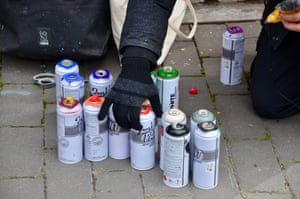
Graff Tours now does graffiti tours, classes and team-building exercises. Photograph: Simon Leigh for the Guardian
A legal, family-friendly version of what was once seen as a symptom of urban blight may seem like a strange formula for success, but in an age where Banksy’s work sells at Sotheby’s, graffiti has become another form of accessible art. “To me, graffiti will always be illegal,” says Schoenberg. When it comes to graffiti, “you need the sneaking around to give it that energy.”


